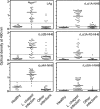Characterization of novel Leishmania infantum recombinant proteins encoded by genes from five families with distinct capacities for serodiagnosis of canine and human visceral leishmaniasis
- PMID: 22144438
- PMCID: PMC3225146
- DOI: 10.4269/ajtmh.2011.11-0102
Characterization of novel Leishmania infantum recombinant proteins encoded by genes from five families with distinct capacities for serodiagnosis of canine and human visceral leishmaniasis
Abstract
To expand the available panel of recombinant proteins that can be useful for identifying Leishmania-infected dogs and for diagnosing human visceral leishmaniasis (VL), we selected recombinant antigens from L. infantum, cDNA, and genomic libraries by using pools of serum samples from infected dogs and humans. The selected DNA fragments encoded homologs of a cytoplasmic heat-shock protein 70, a kinesin, a polyubiquitin, and two novel hypothetical proteins. Histidine-tagged recombinant proteins were produced after subcloning these DNA fragments and evaluated by using an enzyme-linked immunosorbent assays with panels of canine and human serum samples. The enzyme-linked immunosorbent assays with different recombinant proteins had different sensitivities (67.4-93.0% and 36.4-97.2%) and specificities (76.1-100% and 90.4-97.3%) when tested with serum samples from Leishmania-infected dogs and human patients with VL. Overall, no single recombinant antigen was sufficient to serodiagnosis all canine or human VL cases.
Figures






References
-
- Desjeux P. Leishmaniasis: current situation and new perspectives. Comp Immunol Microbiol Infect Dis. 2004;27:305–318. - PubMed
-
- Ministry of Health, Brazil . Manual de Vigilância e Controle da Leishmaniose Visceral. Brasilia. Brazil: Ministry of Health; 2003.
-
- Desjeux P. The increase in risk factors for leishmaniasis worldwide. Trans R Soc Trop Med Hyg. 2001;95:239–243. - PubMed
-
- Mauricio IL, Howard MK, Stothard JR, Miles MA. Genomic diversity in the Leishmania donovani complex. Parasitology. 1999;119:237–246. - PubMed
-
- Lukes J, Mauricio IL, Schonian G, Dujardin JC, Soteriadou K, Dedet JP, Kuhls K, Tintaya KW, Jirku M, Chocholova E, Haralambous C, Pratlong F, Obornik M, Horak A, Ayala FJ, Miles MA. Evolutionary and geographical history of the Leishmania donovani complex with a revision of current taxonomy. Proc Natl Acad Sci USA. 2007;104:9375–9380. - PMC - PubMed
Publication types
MeSH terms
Substances
LinkOut - more resources
Full Text Sources
Other Literature Sources

